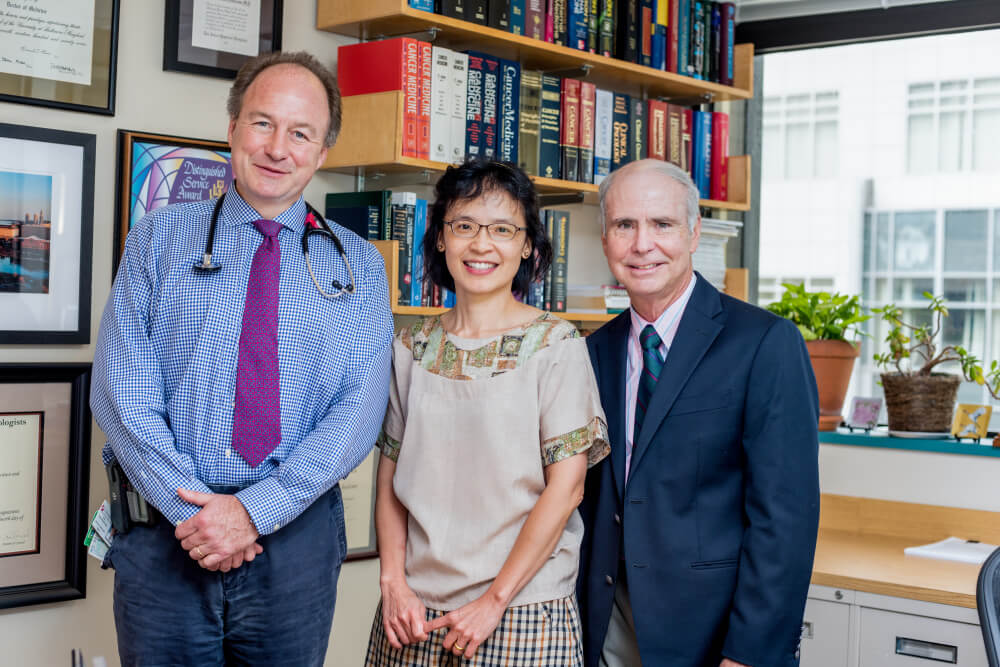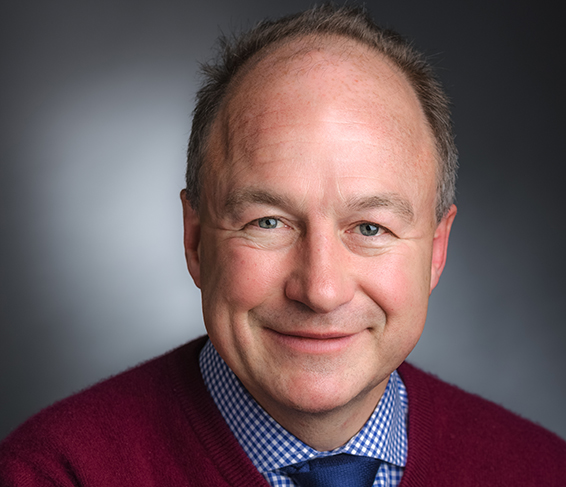Key Takeaways:
- An array of new drugs — which are approved or in clinical testing — have been developed as improvements to conventional therapies for multiple myeloma.
- These new approaches are producing better results for patients, with fewer side effects.
For many patients with multiple myeloma, a new generation of drugs and drug combinations is producing better outcomes and fewer side effects. In recent months, several novel therapies studied and tested by Dana-Farber scientists have gained approval from the U.S. Food and Drug Administration (FDA) or taken a step toward approval after posting solid results in clinical trials.
The drugs are the fruit of years of research into improving treatment for multiple myeloma, a cancer of white blood cells known as plasma cells in the bone marrow. Many of the new agents are biologically derived — made from substances such as proteins and antibodies found in living things — and target biological mechanisms in a very specific, targeted fashion. Dana-Farber researchers have played a key role in these efforts.
“These are each powerful examples of how next-generation novel therapies translated here at Dana-Farber from bench to bedside are further improving outcomes for our patients, and at a remarkable pace,” says Paul G. Richardson, MD, clinical program leader and director of clinical research at the Jerome Lipper Multiple Myeloma Center at Dana-Farber.
Option for relapsed or refractory (non-responsive) myeloma
Following a Dana-Farber-led clinical trial, the FDA recently approved the novel drug isatuximab in combination with pomalidomide and dexamethasone for adults with relapsed or refractory (non-responsive) myeloma who have received at least two prior therapies, including lenalidomide and drugs known as proteasome inhibitors. The drug went into trials after laboratory work by Dana-Farber’s Yu-Tzu Tai, PhD, and Kenneth Anderson, MD, showed it was active against myeloma cells. In the clinical trial, the three-drug combination lowered the risk that the disease would progress by 40%, compared to pomalidomide and dexamethasone alone.

A drug that doesn’t cause hair loss
Dana-Farber investigators conducted laboratory research and led the first clinical trial of the drug melflufen plus dexamethasone in patients with relapsed or refractory myeloma. Melflufen is a “peptide conjugate” drug — made of a stub of protein, or peptide, joined to a chemotherapy agent — and delivers a toxic payload directly to myeloma cells in a selective, time-sparing approach.
Results from an early-phase clinical trial published in Lancet Oncology showed the drug is active in patients with myeloma and is safe at recommended doses. Unlike the previously used standard drug melphalan, it doesn’t cause mucositis — inflammation of membranes within the digestive tract — or hair loss. The results prompted investigators to launch two larger trials, some of whose results are being processed and are due to be published soon.
Drug for patients eligible for stem cell transplant
In a major study published in Blood, Dana-Farber researchers and their associates found that in patients newly diagnosed with myeloma who are eligible for a stem cell transplant, adding the drug daratumumab to the standard three-drug regimen produced more responses, and deeper responses, than in patients receiving the three-drug therapy alone.
Targeting myeloma cells and cell division
Dana-Farber researchers were involved in the development and initial testing of the drug belantamab mafodotin, which has shown considerable promise in clinical trials and has been granted priority review for approval by the FDA.
An antibody conjugate drug consisting of an antibody that specifically targets myeloma cells and an agent that disrupts cell division, its use was informed by a preclinical trial at Dana-Farber involving Yu-Tzu Tai, PhD, and Kenneth Anderson, MD. Belantamab mafodotin was tested in studies led by Paul Richardson, MD, in patients with relapsed or refractory multiple myeloma whose disease continued to worsen after a stem cell transplant, chemotherapy, or other treatment. In the DREAMM-1 and -2 trials, the drug showed strong anti-myeloma activity with manageable side effects.
About the Medical Reviewer

After certification in Internal Medicine, Hematology and Medical Oncology, as well as working in Cancer Pharmacology from 1994 onwards at Dana-Farber Cancer Institute (DFCI), Dr. Paul Richardson joined the Jerome Lipper Myeloma Center in 1999, was appointed Clinical Director in 2001, and led the development of several first-generation novel drugs including bortezomib, lenalidomide and pomalidomide for the treatment of multiple myeloma. Subsequent studies have focused on next-generation novel drugs including panobinostat and second-generation proteasome inhibitors including ixazomib. More recently, his clinical innovations have been in the development of the breakthrough monoclonal antibodies elotuzumab and daratumumab for the treatment of both untreated and relapsed myeloma, as well as isatuximab and more broadly, antibody drug conjugates including belantamab mafodotin, as well as other immunotherapeutic strategies. In addition to these agents, he is leading the development of melflufen, a targeted cytotoxic and a first-in-class small molecule inhibitor selinexor, which inhibits XPO-1, a key nuclear export protein, as well as first-in-human studies of cereblon E3 ligase modulators (so called CELMoDs) for the treatment of relapsed and refractory myeloma. Over the last decade, his major effort has been focused on the development of lenalidomide, bortezomib and dexamethasone (so-called RVD), and its incorporation as part of the Intergroup Francophone Myelome (IFM)/DFCI clinical trial in newly diagnosed patients eligible for stem cell transplant treated with RVD. This regimen has generated an unprecedented response rate, leading to its adoption in this international study, as well as others in the United States and elsewhere. This particular trial incorporates genomic and proteomic evaluation to establish a future platform for tailored therapy and the optimal positioning of stem cell transplant, with results anticipated in 2021-22. Furthermore, RVD has been established as a backbone to which next-generation agents are being added, including elotuzumab, daratumumab and isatuximab, as well as panobinostat. He has published extensively, having authored or co-authored over 400 original articles and 330 reviews, chapters, and editorials in peer-reviewed journals. In addition to holding positions on the Editorial Boards of leading journals, he is prior Chairman of the Multiple Myeloma Research Consortium (MMRC), Clinical Trials Core, a position held for 5 years as part of a rotating tenure, and for which he continues as a member of the Steering and Project Review Committee. He was also a member of ASCO Hematologic Malignancies Subcommittee for the required one-year term, and then for one year on the ASCO Internet Cancer Information Committee during 2017. He was appointed Chair of the Alliance Myeloma Committee in 2011 and continues in this role. Honors include the George Canellos Award for Excellence in Clinical Research and Patient Care, and The Tisch Outstanding Achievement Award for Clinical Research, as well as an honorary Fellowship of the Royal College of Physicians (UK), given in recognition for international contributions in multiple Myeloma and stem cell transplantation. He was a co-recipient of the prestigious Warren Alpert Foundation Prize in recognition of the successful therapeutic targeting of the ubiquitin-proteasome pathway in 2012. He was also a co-recipient of the Accelerator Award for contributions to clinical research and patient enrollment in MMRC studies, as well as for the Research Center of the Year Award in 2009, followed by the second award for Center of the Year in 2017. He was ranked by Thomson Reuters Science Watch amongst the top 19 investigators at DFCI for the most highly cited research in 2016. He was the co-recipient of the ASH Ernest Beutler Prize for clinical science and translational research in the development of proteasome inhibition as an effective treatment strategy for multiple myeloma in 2015; the COMY Award for MM research (Paris, France) in 2016, and the prestigious IMF Robert A. Kyle Lifetime Achievement Award in 2017, and the Morse Research Award in 2019.

Do any of these therapies have a place in patients in remission currently taking Revlimid?
Hi James,
Thank you for reading. Paul Richardson, MD, says that these therapies are not needed unless and until REV fails. If you have any questions, be sure to talk to a doctor about what’s best for you.
Best,
DFCI
With deepest appreciation and gratitude for your devotion to new treatments. I feel blessed that you three head the Multiple Myeloma team and continue to work tirelessly to give us more years to enjoy our lives. Susan Kreitzer Manchester Vermont (7 year MM patient)
How often should a patient with MGUS have their blood tested?
Hi Jerilyn,
Thank you for reading. Irene Ghobrial, MD, notes that it depends, but usually once a year. Your care team can provide medical advice specific to your situation.
Wishing you the best,
DFCI